📞+86 153 7530 2641 📧 hongjing.Wang@feichuncables.com

Port Cables vs. Marine Cables: Structure, Standards & Application Insights
Discover the key differences between port cables and marine cables in this detailed guide. Explore their structures, standards, and applications in Australian ports like Melbourne, Brisbane, and Fremantle, and offshore projects. Perfect for engineers and procurement professionals seeking informed cable selection.
hongjing.Wang@Feichun
7/4/20258 min read
Introduction: The Vital Role of Cables in Ports and Offshore Systems
Australia’s ports, led by the Port of Melbourne, the nation’s largest container hub handling over 3.3 million TEUs (twenty-foot equivalent units) annually, are the backbone of its trade economy. From the iron ore exports of Port Hedland to the diverse cargo of Fremantle, these ports rely on advanced equipment like Ship-to-Shore (STS) cranes, Rubber-Tyred Gantries (RTGs), and shore power systems to keep goods moving efficiently. Meanwhile, offshore, in regions like the Bass Strait, marine cables power wind farms, oil platforms, and subsea communication systems, ensuring reliable energy and data transmission in harsh marine environments.
The global push for greener ports and the expansion of offshore renewable energy have spiked demand for specialized cables. Green port initiatives, such as shore power systems (cold ironing), reduce ship emissions, while offshore wind farms require robust cables to transmit power over long distances. Automation in ports, driven by technologies like Automated Guided Vehicles (AGVs), further complicates cable requirements, demanding solutions that handle both power and data under intense mechanical stress.
This article aims to clarify the distinctions between port cables and marine cables, exploring their definitions, structural differences, industry standards, and application scenarios. By understanding these differences, engineers, procurement professionals, and stakeholders in Australia and beyond can make informed decisions to ensure safety, efficiency, and compliance in their projects. We’ll also address common cable problems and solutions, providing practical insights for port and offshore operations.
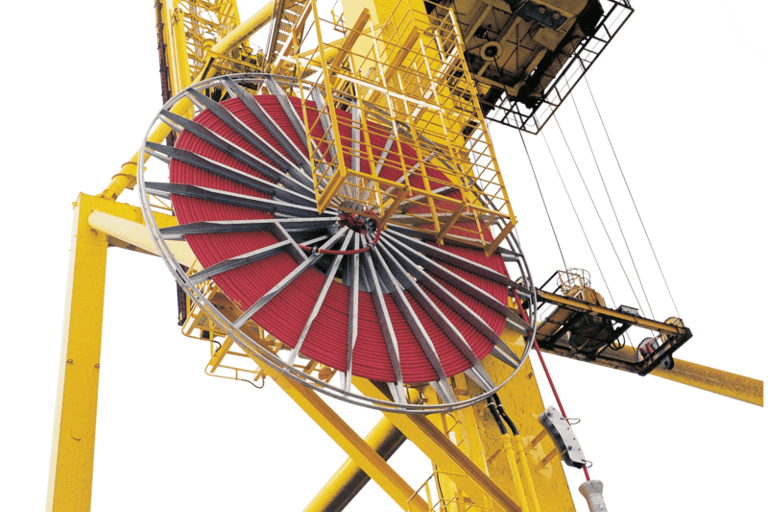

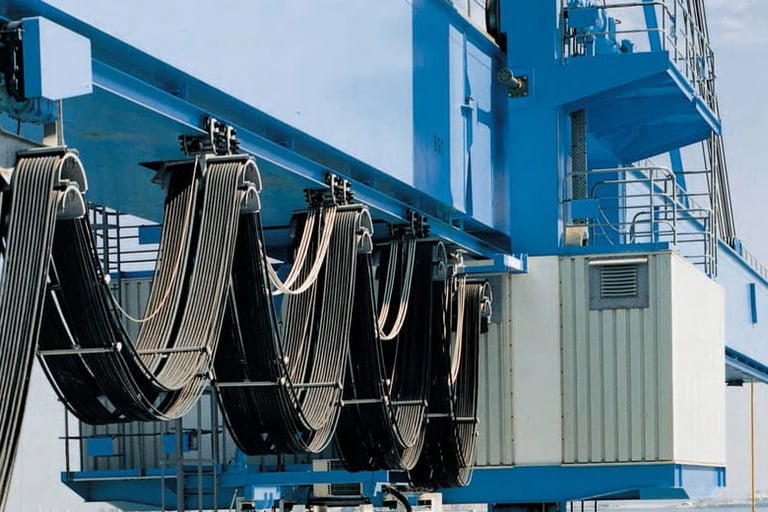

Definitions & Basic Concepts
Port Cables
Port cables are designed for use within port terminals, powering and controlling equipment like cranes, AGVs, and shore power systems. These cables must withstand dynamic movements, frequent bending, and harsh coastal conditions, including UV radiation, salt spray, and oil exposure. They are critical for maintaining operational efficiency in high-throughput ports like the Port of Melbourne.
Examples:
Reeling Cables: Used in STS cranes, these cables wind and unwind repeatedly, requiring high flexibility and tensile strength.
Drag Chain Cables: Employed in AGVs and conveyor systems, these cables flex within drag chains, resisting wear from constant movement.
Shore Connection Cables: Deliver power to berthed ships, reducing emissions by allowing vessels to shut off engines.
Standards:
AS/NZS 2802: Australian/New Zealand standard for heavy-duty flexible cables, ensuring mechanical and electrical performance.
IEC 60245: International standard for rubber-insulated cables, specifying construction and testing.
VDE: German standards for high-quality cable performance.
CE: European conformity mark for safety and environmental compliance.
UL: Underwriters Laboratories certification for safety.
Marine (Offshore) Cables
Marine cables are engineered for offshore environments, including ships, oil platforms, wind farms, and subsea communication systems. They must endure prolonged seawater exposure, high pressures, and corrosive conditions, with a strong emphasis on fire safety and reliability in isolated settings.
Examples:
Shipboard Power/Control Cables: Distribute power and control signals on vessels, requiring fire-resistant, halogen-free materials.
Subsea Optical Fiber Cables: Laid on the seabed for telecommunications, protected against marine life and currents.
Offshore Wind Farm Cables: Include array cables (connecting turbines), export cables (to shore), and interconnect cables (between farms), designed for underwater durability.
Standards:
IEC 60092: Series for electrical installations on ships, covering power, control, and communication cables.
NEK 606: Norwegian standard for offshore cables, focusing on durability in harsh conditions.
DNV, ABS, BV: Classification societies providing type approval for marine cables, ensuring safety and performance.
Lloyd’s Register: Certifies cables for maritime applications.
Structural & Performance Differences
Port and marine cables differ significantly in their design and performance due to their distinct operational environments. The table below summarizes key differences:
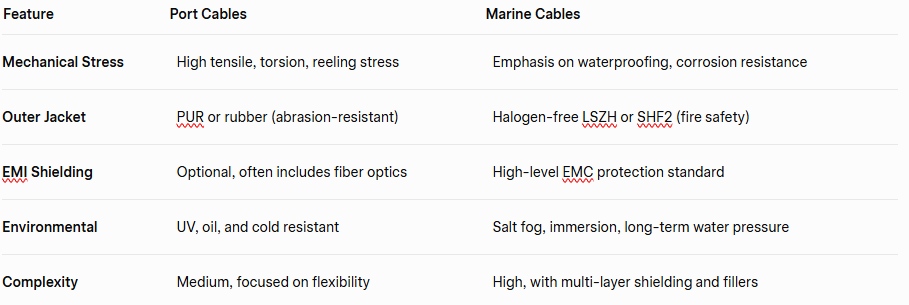

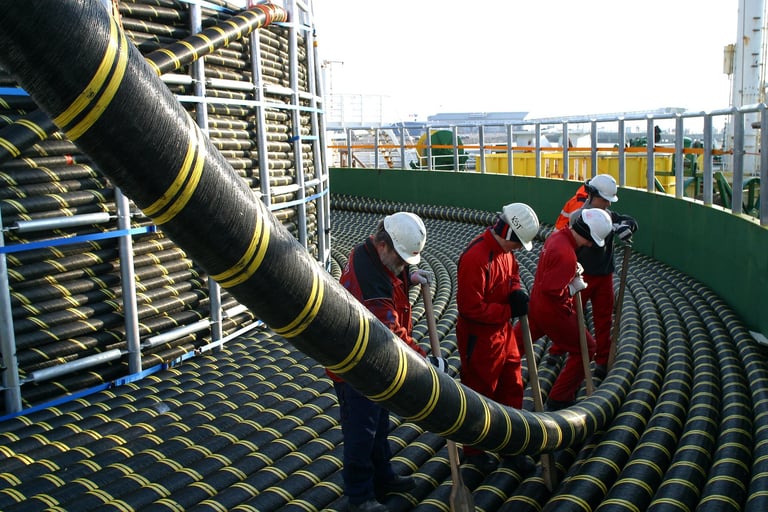

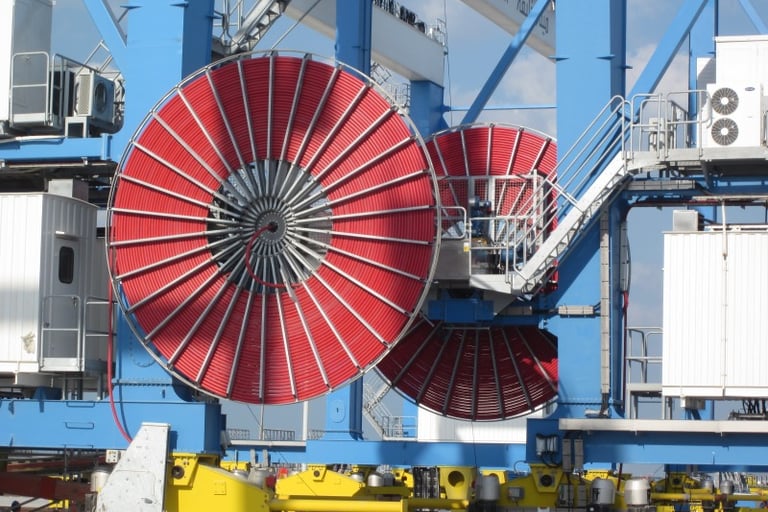

Mechanical Stress
Port cables, used in dynamic applications like STS cranes at the Port of Melbourne, endure high tensile, torsion, and reeling stresses. They must flex repeatedly without breaking, often exceeding 1,000,000 bending cycles. Marine cables, while also facing mechanical stress, prioritize resistance to water ingress and corrosion, as they are often submerged or exposed to seawater on platforms like those in the Bass Strait.
Outer Jacket
Port cables typically use polyurethane (PUR) or rubber sheaths for abrasion resistance, ideal for the rough handling in ports like Brisbane. Marine cables employ halogen-free Low Smoke Zero Halogen (LSZH) or SHF2 materials to minimize smoke and toxicity in case of fire, critical for safety on ships and offshore platforms.
EMI Shielding
Port cables may include optional EMI shielding, particularly in hybrid designs with fiber optics for data transmission, as seen in automated systems at Fremantle. Marine cables require robust EMI protection due to the electromagnetic noise from shipboard equipment and offshore installations, ensuring reliable operation in complex environments.
Environmental Resistance
Port cables are designed to resist UV radiation, oil from machinery, and cold temperatures, common in ports like Port Hedland. Marine cables must withstand salt fog, prolonged immersion, and high water pressure, making them suitable for subsea applications like communication cables in the Tasman Sea.
Complexity
Port cables focus on flexibility and mechanical strength, with a medium level of complexity. Marine cables are more complex, featuring multi-layer insulation, shielding, and armoring to protect against marine conditions, as required in offshore wind farms.
Main Application Scenarios
Port Cable Applications
Port cables are integral to the automation and efficiency of Australian ports, supporting a range of dynamic equipment:
STS Cranes: At the Port of Melbourne, STS cranes load and unload containers, requiring reeling cables that handle frequent winding and high tensile forces. These cables must maintain flexibility and durability to minimize downtime.
RTGs, RMGs, AGVs: Rubber-Tyred Gantries (RTGs), Rail-Mounted Gantries (RMGs), and Automated Guided Vehicles (AGVs) at ports like Brisbane and Fremantle rely on drag chain cables for power and data, flexing within moving systems without wear.
Shore Power Connections (Cold Ironing): Shore power systems, increasingly common in ports like Sydney, supply electricity to berthed ships, reducing emissions. Cables must be robust, safe, and compliant with AS/NZS1747.
Reeling Systems: These deliver power and data to mobile equipment, requiring cables that withstand constant bending and stretching, as seen in automated stacking systems.
Marine Cable Applications
Marine cables support offshore operations, enduring harsh subsea and maritime conditions:
Offshore Oil Platforms: In regions like the North West Shelf, power and control cables operate in corrosive environments, requiring resistance to saltwater and potential fire hazards.
Shipboard Electrical Systems: On vessels, cables distribute power and control signals, needing halogen-free, fire-resistant materials to ensure safety in confined spaces.
Offshore Wind Farms: In the Bass Strait, array cables connect turbines, export cables transmit power to shore, and interconnect cables link farms, all designed for underwater durability.
Subsea Communication Systems: Optical fiber cables laid on the seabed, such as those connecting Australia and New Zealand, support global telecommunications, protected against marine life and currents.
Standards & Certifications
Both port and marine cables must adhere to strict standards to ensure safety and performance:
Port Cables
AS/NZS 2802: Governs heavy-duty flexible cables, ensuring mechanical and electrical reliability for dynamic port applications.
IEC 60245: Specifies construction and testing for rubber-insulated cables, widely used in port equipment.
VDE: German standards for high-quality cable performance, often applied in crane and reeling systems.
UL: Safety certification for electrical equipment, ensuring compliance with international standards.
CE: Indicates conformity with European health, safety, and environmental protection standards.
Marine Cables
IEC 60092 Series: Covers electrical installations on ships, including power, control, and communication cables, ensuring safety and reliability.
NEK 606: Norwegian standard for cables in offshore installations, focusing on durability in harsh marine conditions.
DNV, ABS, BV, Lloyd’s Register: Classification societies providing type approval for marine cables, ensuring compliance with maritime safety standards.
Key Differences:
Fire Resistance: Marine cables prioritize halogen-free, low-smoke materials (LSZH/SHF2) to minimize risks in confined spaces, while port cables may use flame-retardant rubber or PUR.
Explosion-Proof: Marine cables often require explosion-proof certifications for use in hazardous areas like oil platforms, less common in port environments.
Design & Selection Considerations
Choosing between port and marine cables requires careful evaluation of several factors:
Environmental Conditions: Port cables must resist UV, oil, and temperature variations, as seen in Fremantle’s coastal climate. Marine cables need to withstand saltwater immersion, high pressure, and corrosion, critical for offshore wind farms.
Installation Type: Port cables are often dynamic, used in reeling or drag chain systems, requiring high flexibility. Marine cables may be fixed (e.g., subsea) or dynamic (e.g., shipboard), with designs tailored to specific conditions.
Voltage Levels and Derating: Select cables based on equipment power requirements, with derating calculations for long runs or high temperatures to ensure safe operation.
Maintenance and Replacement: Port cables require regular inspections for wear due to movement, while marine cables need robust designs to minimize maintenance in hard-to-access offshore locations.
Future Trends & Technical Development
The cable industry is evolving to meet the demands of green ports and offshore energy:
Green Port Initiatives: Ports like Melbourne are adopting low-carbon cables with eco-friendly materials, reducing environmental impact during production and operation.
Offshore Wind Expansion: Projects in the Bass Strait drive innovation in marine cables, with designs for higher voltages, longer distances, and deeper waters.
Hybrid Cables: Integrating power, control, and fiber optics, as seen in Feichun’s Type (N)TSKCGEWÖU, reduces installation complexity and supports automation.
Smart Cable Systems: Embedded sensors for monitoring temperature, tension, and wear enable predictive maintenance, improving reliability in both port and offshore applications.
Questions and Answers: Addressing Potential Port Cable Problems
Q1: What are the main differences between port and marine cables?
Port cables prioritize flexibility and tensile strength for dynamic applications like cranes at the Port of Melbourne, while marine cables focus on waterproofing and fire safety for offshore use, such as in Bass Strait wind farms.
Q2: How do I choose between port and marine cables for my project?
Assess the environment and application. For dynamic port equipment like AGVs, choose port cables with PUR sheaths. For subsea or shipboard systems, select marine cables with LSZH materials and DNV certification.
Q3: What standards should I look for when purchasing these cables?
For port cables, ensure compliance with AS/NZS2802 and IEC60245. For marine cables, look for IEC60092, NEK606, and certifications from DNV or ABS to guarantee safety and performance.
Q4: How can I ensure cable longevity in harsh environments?
Regular inspections, adherence to bending radius guidelines, and compliance with AS/NZS1747 for ports or DNV for offshore systems prevent wear, corrosion, and insulation failure. Use UV-resistant sheaths for ports and waterproof designs for marine applications.
Q5: What are common cable problems and how can they be mitigated?
Mechanical wear, corrosion, and EMI are common. Kevlar-reinforced port cables, like Feichun’s Type (N)TSKCGEWÖU, resist wear, while marine cables with LSZH sheaths prevent corrosion. Shielding mitigates EMI in both.
Q6: Are there cost benefits to choosing the right cable?
Selecting the appropriate cable reduces maintenance and downtime costs. Hybrid port cables lower installation complexity, while durable marine cables minimize replacements in offshore settings.
Q7: What emerging technologies should I be aware of?
Hybrid cables and smart systems with embedded sensors are transforming both port and marine applications, offering improved efficiency and predictive maintenance capabilities.
Conclusion
Port cables and marine cables serve distinct but complementary roles in Australia’s maritime and offshore industries. Port cables, designed for dynamic applications like STS cranes and shore power at the Port of Melbourne, prioritize flexibility and tensile strength, adhering to standards like AS/NZS2802. Marine cables, built for offshore platforms and wind farms, focus on waterproofing and fire safety, meeting IEC60092 and DNV requirements. By understanding their structural differences, standards, and applications, stakeholders can select the right cable for their needs, ensuring safety, efficiency, and compliance. For critical projects, consulting professional manufacturers like Feichun Cables for tailored solutions is recommended to optimize performance and longevity.
How to Reach Us
Get in Touch
SiteMap
Product Catalogue
Reeling Cable
Festoon Cable
Shore Power Cable




Scan to add us on WeChat
